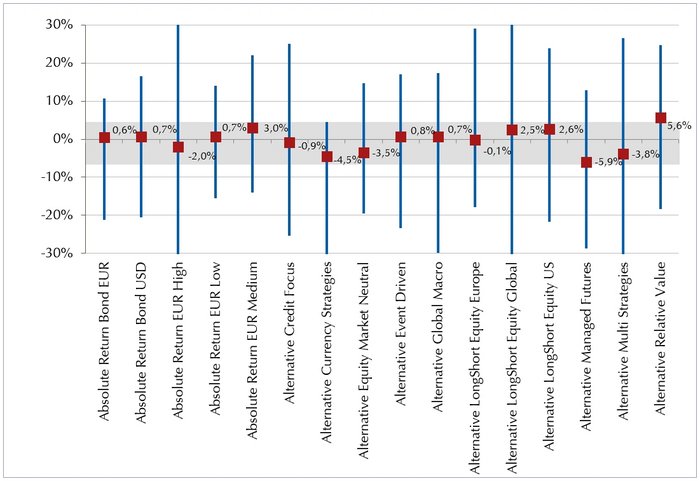Frankfurt, March 04th, 2021: 2020 was a difficult year for absolute return and liquid alternatives strategies in Germany following sharp losses in March. Investors reacted to the highest drawdowns of the past five years with outflows from the asset class of €25 billion. This development mainly affected the smaller funds, while large funds were able to gain market share. By the end of the year, however, most funds had largely to fully recovered their losses – the bottom line was an average performance of 1.34%. This is the result of Lupus alpha’s semi-annual absolute return study based on data from Refinitiv.
Since 2008, Lupus alpha has been analysing the universe of absolute return and liquid alternatives funds in the UCITS mantle with an active management approach that are authorised for distribution in Germany. Fund assets under management in this segment fell by 9.1% year-on-year to €249 billion. This made fund outflows the most noticeable trend in the corona year 2020, which saw the highest volatilities since liquid options markets came into existence, surpassing even the crisis year 2008. Investors withdrew from more than a quarter of the funds, even though they were performing flat to positive at the end of the year. Even funds with slightly negative returns of up to −5% were strongly affected by outflows. Both groups comprise almost three-quarters of all funds in this asset class.
‘In retrospect, it must be said that investors were too quick to withdraw from this asset class, even though their risk budgets were under great pressure in the meantime. Those who remained loyal to their manager in this difficult market situation fared better than an investor who withdrew his trust at the low point of the crisis,’ says Ralf Lochmüller, CEO and Managing Partner of Lupus alpha. ‘It will be interesting to observe whether investors, against the backdrop of this experience, place more trust in their managers during market crises in the future,’ Lochmüller continues.
The withdrawal from the asset class mainly affected the smaller 80% of funds with an average fund volume of less than €17 million. These funds lost almost half of their capital, while the assets managed in the large funds fell by only just under 12%.
The funds in the upper quintile, some of which are worth billions, were able to expand their dominance and managed more than 80% of the total capital at the end of the year. Only lower-risk strategies (Alternatives Credit Focus) and relative value approaches as well as strategies that profit from larger market movements (Global Macro, Event Driven) recorded inflows. Accordingly, these strategies have been able to expand their market share. In particular, measured in terms of total market volume, the share of the Global Macro, Alt. Credit Focus and Event Driven strategies grew significantly.
Alternative Relative Value strategies achieved the best average performance with 5.6%, while funds in the Alternative Multi Strategies segment were at the lower end with an average of −5.9%. However, the spread of performance within the individual strategies was also considerable in 2020. The extremely high fluctuation margins per strategy reveal once again that the result is largely determined by the selected manager and less by the selected strategy.


